

NASAs 'Curiosity' Search for Life Targets Water-Altered Rock. This rock's composition is unlike any other Opportunity has investigated during nine years on Mars -- higher in aluminum and silica, lower in calcium and iron.
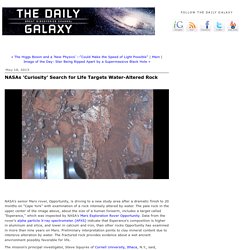
"Based on our current solar-array dust models, we intend to reach an area of 15 degrees northerly tilt before Opportunity's sixth Martian winter," said JPL's Scott Lever, mission manager. "Solander Point gives us that tilt and may allow us to move around quite a bit for winter science observations. " Northerly tilt increases output from the rover's solar panels during southern-hemisphere winter. Daily sunshine for Opportunity will reach winter minimum in February 2014. The rover needs to be on a favorable slope well before then. What is the relationship between the moon and the tide? a WebQuest. Links verified 1/1/2012 Written by Bill Byles Introduction | Task | Process | Evaluation | Conclusion | Teacher's section "OK, here's the deal.

" The gruff inspector snarled as he spoke to your team of detectives. "For a long time people have been blamin' things on the moon! The Moon l Phases, Orbit and distance from the Earth. The Moon is the only natural satellite of Earth: orbit: 384,400 km from Earth diameter: 3476 kmmass: 7.35e22 kg History of The Moon Called Luna by the Romans, Selene and Artemis by the Greeks, and many other names in other mythologies.
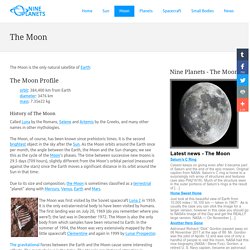
The Earth's Moon. The Earth's Moon NASA.
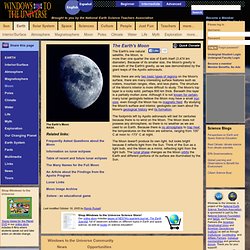
The Earth's one natural satellite, the Moon, is more than one quarter the size of Earth itself (3,474 km diameter). Because of its smaller size, the Moon's gravity is one-sixth of the Earth's gravity, as we saw demonstrated by the giant leaps of the Apollo astronauts. While there are only two basic types of regions on the Moon's surface, there are many interesting surface features such as craters, mountain ranges, rilles, and lava plains.
The structure of the Moon's interior is more difficult to study. The Moon's top layer is a rocky solid, perhaps 800 km thick. Solar System, Solar System Information. Our Cosmic Neighborhood From our small world we have gazed upon the cosmic ocean for thousands of years.

Ancient astronomers observed points of light that appeared to move among the stars. Heavens-Above Home Page. Home and City. October 24, 1999 - The Magnetic Carpet Of The Sun. Discover the cosmos!

Each day a different image or photograph of our fascinating universe is featured, along with a brief explanation written by a professional astronomer. October 24, 1999 The Magnetic Carpet Of The Sun Credit: SOHO Consortium, ESA, NASA Explanation: The Sun has a magnetic carpet. Its visible surface appears to be carpeted with tens of thousands of magnetic north and south poles joined by looping field lines which extend outward into the Solar Corona. Tomorrow's picture: Neptune Past Red Authors & editors: Robert Nemiroff (MTU) & Jerry Bonnell (USRA)NASA Technical Rep.: Jay Norris. October 8, 1998 - Far Side of the Moon.
September 23, 1999 - Equinox and Eruptive Prominence. 2008 June 1 - A Twisted Solar Eruptive Prominence. Discover the cosmos!
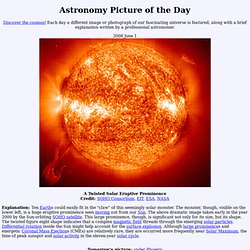
Each day a different image or photograph of our fascinating universe is featured, along with a brief explanation written by a professional astronomer. 2008 June 1 A Twisted Solar Eruptive Prominence Credit: SOHO Consortium, EIT, ESA, NASA Explanation: Ten Earths could easily fit in the "claw" of this seemingly solar monster. The monster, though, visible on the lower left, is a huge eruptive prominence seen moving out from our Sun. Tomorrow's picture: under Phoenix Authors & editors: Robert Nemiroff (MTU) & Jerry Bonnell (UMCP)NASA Official: Phillip Newman Specific rights apply.NASA Web Privacy Policy and Important NoticesA service of:ASD at NASA / GSFC& Michigan Tech. 2002 July 18 - Sunspot Region 30. Discover the cosmos!

Each day a different image or photograph of our fascinating universe is featured, along with a brief explanation written by a professional astronomer. 2002 July 18. 2002 November 14 - The Sharpest View of the Sun. Discover the cosmos!
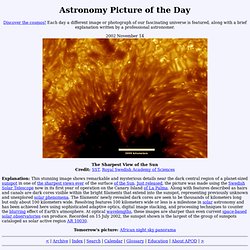
Each day a different image or photograph of our fascinating universe is featured, along with a brief explanation written by a professional astronomer. 2002 November 14 Explanation: This stunning image shows remarkable and mysterious details near the dark central region of a planet-sized sunspot in one of the sharpest views ever of the surface of the Sun. Just released, the picture was made using the Swedish Solar Telescope now in its first year of operation on the Canary Island of La Palma. Along with features described as hairs and canals are dark cores visible within the bright filaments that extend into the sunspot, representing previously unknown and unexplored solar phenomena.
March 26, 1999 - Impact Moon. Discover the cosmos!

Each day a different image or photograph of our fascinating universe is featured, along with a brief explanation written by a professional astronomer. March 26, 1999 Impact Moon Image Credit: Galileo Project, JPL, NASA Explanation: The Moon's surface is covered with craters, scars of frequent impacts during the early history of the solar system. Earth View. Solstice & Equinox Dates 2010-2019. Predefined Locations for Sunrise Sunset Calendar.
Complete Sun and Moon Data for One Day. Use these forms to obtain rise, set, and transit times for the Sun and Moon; civil twilight beginning and end times; and, lunar phase information. First, specify the date and location in one of the two forms below. Then, click the "Get data" button at the end of the form.